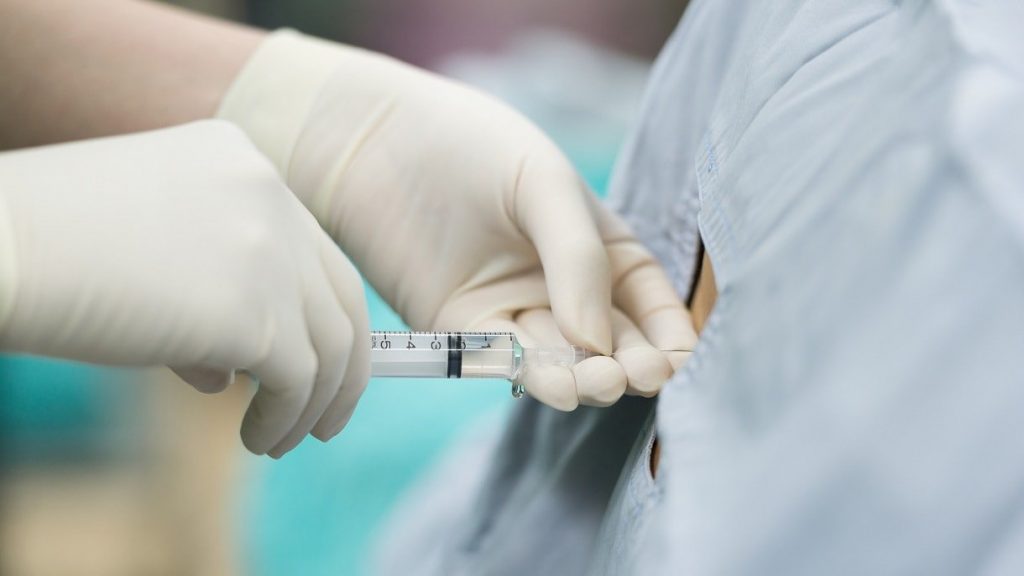Table of Contents
- What is an Epidural Steroid Injection?
- Why Might I Need an Epidural Injection?
- What are the Risks of an Epidural Steroid Injection?
- How to Prepare for the Injection?
- What is the Recovery Time for an Epidural Steroid Injection?
- See a Spine Specialist
Epidural injections are used for several purposes that include administering an anesthetic to women during child delivery or steroid medications to relieve neck and back pain or pain in the arms and legs associated with a spinal condition. The epidural steroid injection as a form of treatment for acute and chronic pain is effective and considered safe.
What is an Epidural Steroid Injection?
An epidural steroid injection is used to relieve back pain in the cervical, thoracic and lumbar areas of the spine. The pain management injections are also used to reduce pain in other parts of the body, like the back of the legs or the arms, when the pain is due to nerve inflammation in the spine. The medication reduces pain by reducing inflammation associated with one or more nerve roots that are compressed due to injury or disease.
When a nerve is compressed, it becomes inflamed. Inflammation can trigger pain, tingling or numbness along the nerve. Numbness may also develop.
The epidural space is the space that exists between the inner and outer layers of a membrane covering the spinal cord. The epidural space is inside the spinal canal but outside the spinal cord. This is the targeted area of the epidural steroid injection. The epidural extends from the base of the skull to the S2 bone in the sacral spine at the end of the backbone.
The physician determines the best place to inject the steroid, which can be anywhere along the spine. The injection is often referred to by the spinal area – cervical, thoracic or lumbar epidural steroid injection.

Why Might I Need an Epidural Injection?
There are two main reasons epidural injections are suggested. One is to provide temporary pain relief so a patient can better pursue a rehabilitation program. The second reason is to ease the pain associated with a medical condition.
Common medical conditions that may be treated with epidural injections include:
- Spinal stenosis
- Herniated disc
- Bone spurs
- Degenerative disc disease
- Pinched nerve
- Sciatica
- Facet joint arthritis
- Radiating pain from the spine
- A compression fracture in the vertebra
- Failed back surgery syndrome
Sometimes, epidural injections are also used to pinpoint a source of pain. The epidural steroid injection is for temporary pain relief and is not a cure. It may last for weeks for months. The physician uses the injection as an element of a larger rehabilitation or pain management program.

What are the Risks of an Epidural Steroid Injection?
There are always risks associated with any medical procedure. The epidural injection is considered to be very safe, but epidural steroid injection complications can occur in rare cases.
The potential side effects of epidural injections include the following:
- Allergic reaction
- The needle is injected too deep and punctures the tissue surrounding the spinal cord, making it possible for spinal fluid to leak
- The needle touches the nerve root of the spinal cord and causes neurologic injury felt as tingling or numbness in the extremities
- Bacterial or fungal infection in the spinal canal
- Increased pain
- Bleeding
- Elevated blood sugar
Most people do not experience any complications. A study published on the National Institutes of Health website (doi: 10.7759/cureus.723) found that epidural injections for sciatica led to significant improvement in functional disability scores and pain scores, and more than 80 percent of people with chronic sciatica caused by lumbar disc herniation were able to avoid surgery. There are risks, but for many people, the potential benefits far outweigh the epidural injection risks.
Epidural Steroid Injection
The preparation procedure for the epidural injection is simple. The patient is usually allowed to eat food a few hours before the injection is administered. Patients can also continue talking medications with the exception of anti-inflammatory or blood-thinning drugs.
The standard procedure is as follows:
- The IV line is inserted in the patient’s vein
- The patient is positioned over a bolster, like a pillow, on an X-ray machine table (an option is to lie on the side or to sit up if pain prevents lying down)
- An x-ray is taken to verify the insertion location
- The skin at the injection site is cleaned and numbed with an anesthetic
- Using fluoroscopy to guide needle insertion, the physician inserts the needle in the epidural space
- If the needle is properly placed, a steroid solution and possibly some anesthetic is injecte
What is the Recovery Time for an Epidural Steroid Injection?
The recovery time after an epidural steroid injection is short. After the injection is completed, most people can leave after 20-30 minutes of monitoring. Driving or operating any machinery for 12 hours should be avoided.
The anesthetic will work within hours and the steroid within a few days. There may be some tenderness where the needle was inserted, but it usually only lasts a few hours.
The physician will advise the patient to rest for the rest of the day. The patient can return to normal activities the next day.
See a Spine Specialist
It is important to understand there are limits on the number of epidural steroid injections a person can receive in a year. It is generally accepted that a patient should only receive 3-4 epidural injections over a 12-month period. In some cases, patients may get them more frequently, but regular injections of steroids can weaken bones in the spine and muscles near the point of the injections.

